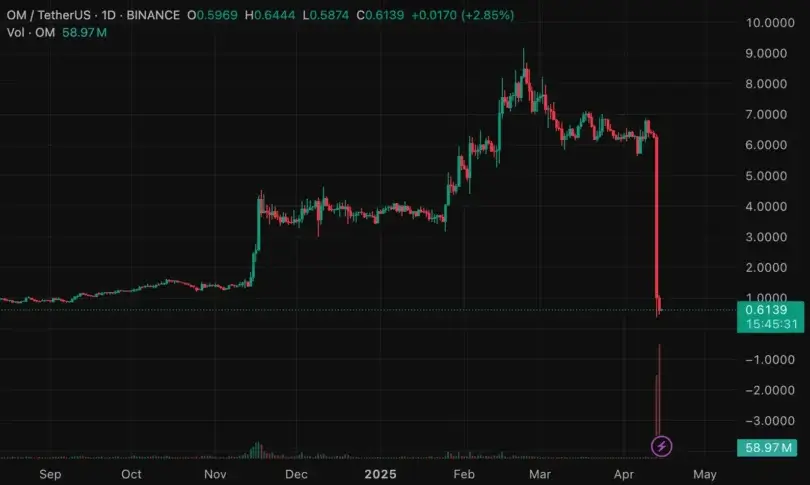MANTRA DAO (OM) Token Crashes by 92% – What Happened?

The MANTRA DAO (OM) token crash shocked the cryptocurrency space by collapsing by 80% in a few hours, dropping by another 12% by Monday morning. This unexpected event left the crypto community with thousands of questions about the project’s further credibility and its long-term prospects. Some influencers on the X app began saying that there was something dubious about this project since its very start as an ICO four years ago.
On Sunday evening, OM traded at $6.3 and then all of a sudden, within just two hours, the price virtually collapsed to $0.5 per single token. The chart just saw two consecutive red candles, where one pushed the OM price down by an astonishing 76%.
To understand what has happened there fully, let’s go through the history of the project’s origin and launch and the events that led to that enormous price crash, which made many investors think that the entire project was a scam from day one.
MANTRA DAO ICO, first suspicions arise
MANTRA coin emerged in the market gloriously and with high expectations at the start of 2021. It was launched as a decentralized layer-1 protocol for tokenizing and trading real-world assets (RWA). Its goal was to lay a bridge between the world of decentralization and traditional financial markets. Among its creators were John Patrick Mullin, Will Corkin, a fintech researcher, and a blockchain entrepreneur. What they wanted was to create a financial ecosystem that would be fair, transparent, and decentralized. It wanted to enable users to stake assets, earn rewards, and participate in making crucial governance decisions by voting using the native OM token.
OM was launched during the Initial Coin Offering (ICO) in 2021, allowing investors to buy it early and thus to get enough tokens to participate in the aforementioned aspects of the platform. The project was positioned as the next big thing in the DeFi space, which made it one of the most-anticipated launches of the year. The ICO garnered a lot of attention back then due to the strong marketing efforts made by the project founders and their huge ambitions to make a blooming ecosystem in the crypto space.
However, the first signs that the project might be suspicious came almost immediately. In a tweet on March 8, 2021, a Chinese crypto journalist, Colin Wu, quite famous on Twitter, slammed MANTRA OM as a scam project whose founders had also opened a casino in China, and the team allegedly also had experience in running fraudulent ICOs. MANTRA coin, per Wu’s tweet, attracted the attention of the Chinese crypto community were surprised why Binance at that time agreed to add OM to its Innovation Zone – a platform for promising new projects.
Wu also claimed that the MANTRA DAO coin team bragged about receiving financial support from FTX but those rumors were later refuted by Sam Bankman-Fried, who is now doing a prison time for defrauding investors of the FTX exchange when he used their deposits in an attempt to save his pocket trading firm Alameda Research from a terminal liquidity crisis.
MANTRA OM’s 92% price collapse
The price crash took place on Sunday, and it occurred just within a couple of hours as the price nosedived from $6.3 to just $0.5, wiping out $6 billion in OM market capitalization value.
After it happened, the major OKX exchange stated on its website, saying that it had noticed major changes to OM tokenomics since October last year, as well as suspicious activity going on a large scale from similar on-chain addresses since March 2024. As for the MANTRA coin team, John Patric Mullin released a statement, blaming the OM price collapse on “reckless forced closures initiated by centralized exchanges on OM account holders,” adding that “the timing and depth of the crash suggest that a very sudden closure of account positions was initiated without sufficient warning or notice.”
He also said that it took place at low-liquidity hours on Sunday, which “points to a degree of negligence at best, or possibly intentional market positioning taken by centralized exchanges.” He also thanked the community for the strong support the team received following the incident.
Mullin continued to put the fault for the crash down on centralized exchanges, which play a great role in providing liquidity to projects like MANTRA. He emphasized that “this dislocation was not caused by the team, the MANTRA DAO Chain Association, its core advisors, or MANTRA’s investors selling tokens.”
He assured the community that OM’s tokenomics remain intact, citing the token report published last week. “Our token wallet addresses are online and visible,” Mullin said, and also warned the community to stay alert and avoid clicking on any links or X accounts that pretend to be somehow affiliated with MANTRA.
Binance exchange, which began to receive accusations of triggering the OM price collapse, tweeted on Monday that they had conducted their research and concluded that the token’s price crashed “a result of cross-exchange liquidations,” and they did not notice any signs of a rug pull.
The X post also revealed that since January 2024, Binance created a pop-up warning for OM on its spot trading page to make traders aware that “the token has undergone significant changes to its tokenomics, increasing its supply.”


